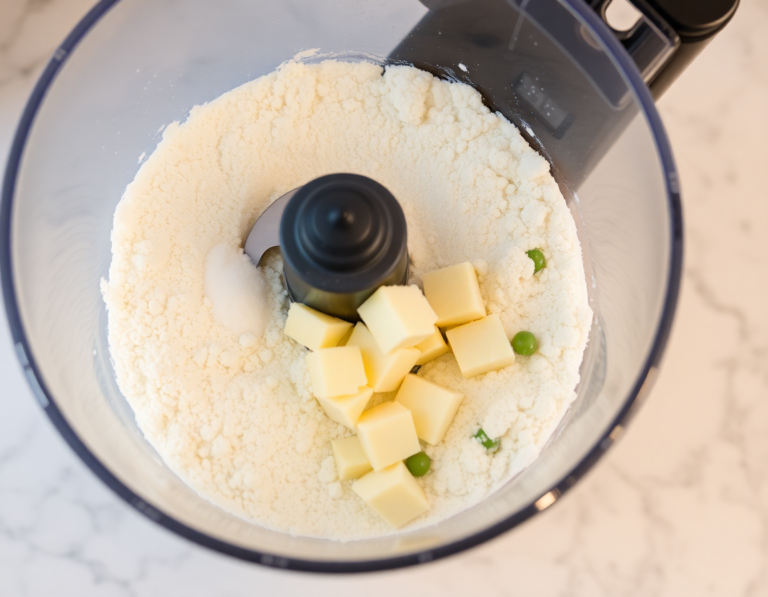Imagine a world where pie crusts are as easy as pie—literally. It’s like discovering your favorite song on a playlist you never knew existed.
One day, while reminiscing about my grandma’s kitchen (where flour seemed to dance in the air), I stumbled upon this ridiculously simple recipe. It’s buttery, flaky, and almost feels like cheating.
. .
but who cares when it tastes this good?
Steps
- In a food processor, combine flour, sugar, and salt by pulsing a few times. Add cold diced butter and pulse until the mixture forms coarse crumbs with some pea-sized pieces.
- Gradually add 7 tablespoons of ice water, pulsing until small clumps or balls of dough form. Test by pinching a piece of dough; it should stick together. If necessary, add more water, one teaspoon at a time, avoiding excess water to prevent sticky dough.
- Transfer the dough to a clean surface, gather it into a ball without kneading, and divide it in half. Flatten each half into a disk, cover with plastic wrap, and refrigerate for at least an hour.
- When ready to use, lightly flour your work surface and roll one disk into a 12-inch circle. Carefully transfer it to a 9-inch pie dish, unrolling it gently and pressing it into the dish.
- Tuck any excess dough under itself to create a double-layered edge. Form a decorative edge by crimping or fluting, then freeze the crust for 30 minutes before baking.
- For blind baking, line the crust with parchment paper and fill with pie weights. Preheat the oven to 425°F, bake for 17 minutes, then remove weights and bake for another 5 minutes until golden. Let cool before using.
Ingredients
- 2 1/2 cups all-purpose flour
- 1 tablespoon granulated sugar
- 1/2 teaspoon salt
- 1 cup unsalted butter, cold and diced
- 7 tablespoons ice water
Nutritional Values
Calories: 2784 kcal | Carbs: 240 g | Protein: 24 g | Fat: 180 g | Saturated Fat: 108 g | Cholesterol: 480 mg | Sodium: 1188 mg | Potassium: 384 mg | Vitamin A: 5640 IU | Calcium: 96 mg | Iron: 14.4 mg
FAQ
- Do I need a food processor to make pie dough?
- No, a food processor is not essential. You can use a pastry cutter to blend the butter into the flour, sugar, and salt mixture. Once the water is added, use a spatula to mix until the dough is evenly moistened.
- Can I prepare pie dough in advance?
- Yes, you can make the pie crust ahead of time. It can be refrigerated for up to three days. Before rolling out, let it soften slightly at room temperature. For longer storage, wrap the dough tightly and freeze for up to three months, thawing completely before use.
- What should I do if my pie dough is too hard?
- If the dough becomes too firm after refrigerating for more than an hour, allow it to rest at room temperature for 10-20 minutes. This will make it easier to roll out.
- What can I use instead of pie weights?
- If you don’t have pie weights, you can use dry raw beans or rice to prevent the crust from puffing up during blind baking. Note that beans should not be cooked afterward but can be reused for future blind baking. Rice can be toasted and used in recipes like pilaf after using it in the crust.
- How do I pre-bake or “blind bake” a pie crust?
- To blind bake, form the crust’s edge (crimp or flute) and freeze for 30 minutes. Line the crust with parchment paper and fill it with pie weights. Bake at 425°F for 17 minutes, then remove the weights and bake for another 5 minutes until the bottom is golden and dry.
Tips
- Chill the Butter: Ensure your butter is cold straight from the fridge when making the pie dough. This helps in achieving a flaky texture, as the cold butter creates steam pockets in the baking process.
- Avoid Overmixing: When combining ingredients, pulse just until you see coarse crumbs and pea-sized butter pieces. Overmixing can lead to a tough crust by developing too much gluten.
- Control Water Addition: Add ice water gradually, a tablespoon at a time, to prevent the dough from becoming too sticky. Check the dough by pinching a small amount; if it holds together, you have added enough water.
- Rest the Dough: After shaping your dough into disks, wrap them in plastic and refrigerate for at least an hour. This resting period allows the gluten to relax, making it easier to roll out and shape.
Equipment
- Food Processor – If you prefer not to use a pastry cutter, a food processor can make cutting the butter into the flour mixture easier.
- Pastry Cutter – An alternative to a food processor for cutting butter into the dry ingredients.
- Rolling Pin – Essential for rolling out the pie dough to the correct size.
- Pie Weights – Used for blind-baking the crust to prevent it from puffing up.
- 9″ Pie Dish – Required for shaping and baking the pie crust.
- Parchment Paper – Used to line the pie crust before adding pie weights for blind-baking.


